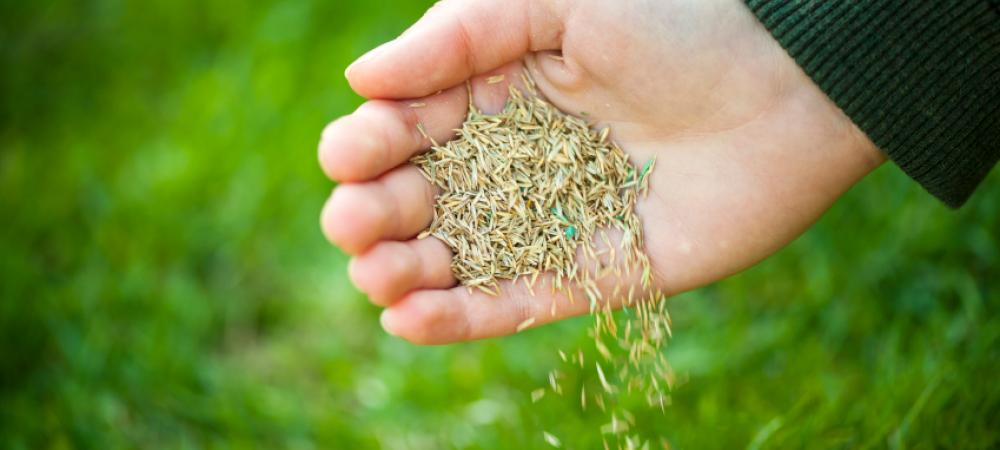Overseeding Your Lawn: When and How to Do It Right

Over time, even the healthiest lawns can start to look thin, patchy, or worn out—especially after summer stress, drought, or heavy use. Overseeding is a smart, low-effort way to revive your lawn by introducing new grass seed into existing turf. This simple practice fills in bare spots, improves color, and creates a thicker, more resilient lawn overall.
Whether you’re trying to recover from damage or just want a fuller, greener lawn, overseeding can make a noticeable difference—without the need to tear up and reseed the whole yard.
Why Overseed Your Lawn?
If your lawn is thinning or patchy, you’re not alone. Grass can weaken over time due to weather, foot traffic, pests, or disease. Overseeding is a proactive way to restore density and encourage healthier turf from the ground up.
Here are a few reasons homeowners choose to overseed each year:
- Improves turf thickness and appearance. Fresh seed fills in bare or thinning areas, creating a fuller, more uniform look.
- Enhances disease and drought resistance. Introducing new, hardier grass varieties strengthens your lawn’s ability to withstand stress.
- Helps crowd out weeds. Dense, healthy grass makes it harder for weeds to gain a foothold.
Regular overseeding doesn’t just fix problems—it helps prevent them by building a healthier lawn long-term.
Best Time to Overseed
Timing is key when it comes to overseeding. You’ll get the best results by working with the seasons and your grass type.
- Cool-season lawns (such as fescue or Kentucky bluegrass) respond best to overseeding in early fall. Soil temperatures are still warm enough for germination, but cooler air temps help new seedlings establish without stress.
- Warm-season lawns (like Bermuda or Zoysia) benefit most from late spring to early summer seeding, when soil temperatures have warmed to around 65–70°F.
Avoid overseeding during extreme heat or cold—seeds won’t germinate well and young grass won’t establish properly.
How to Prepare for Overseeding
Before you spread a single seed, your lawn needs a little prep work. This step is often skipped—but it’s critical for success.
Start by mowing the lawn shorter than usual, then bag the clippings to allow the new seed better access to the soil. Next, rake or dethatch to remove any debris, dead grass, or thatch buildup. This helps loosen the soil surface and gives your seed better contact with the ground.
If possible, perform a soil test to check pH and nutrient levels. Grass seed can struggle in poor soil, and you may need to adjust with lime or other amendments before seeding.
Choosing the Right Seed
Not all grass seed is created equal—and choosing the wrong type can leave you disappointed with the results.
The best approach is to match your seed to your existing grass type. For example, cool-season lawns should stick with cool-season varieties, while warm-season lawns need compatible seed blends. Look for high-quality, weed-free seed to avoid introducing unwanted plants.
Also, think about your yard’s unique conditions. Do you have areas that are shaded for most of the day? Or spots that get heavy foot traffic? Seed blends designed for sun, shade, or durability can help ensure stronger results.
Step-by-Step Overseeding Process
Once your lawn is prepped and you’ve picked the right seed, it’s time to start planting.
- Use a broadcast spreader to apply the seed evenly across your lawn.
- Apply a starter fertilizer immediately after seeding to give seedlings the nutrients they need to get going.
- Water lightly but consistently, keeping the top layer of soil moist for 1–2 weeks. Watering several times a day may be necessary during hot weather.
The goal is to create steady moisture without overwatering—too much water can wash seeds away or encourage fungal growth.
Post-Seeding Care Tips
Your work isn’t over once the seed is down. The next few weeks are all about protecting new growth.
- Avoid mowing until the new grass reaches about 3 inches tall. Cutting too early can damage fragile seedlings.
- Limit foot traffic in newly seeded areas to prevent compaction and protect tender roots.
- Once the new grass blends in with your existing lawn, resume your regular mowing and fertilization routine.
Keep an eye out for uneven growth, and don’t hesitate to touch up bare areas if needed.
Key Takeaways
Overseeding is a low-cost, high-reward lawn care strategy that helps restore thickness, improve turf health, and prevent weed outbreaks. With the right timing, prep, and care, you can turn a tired lawn into a lush, thriving one in just a few weeks.
If you're unsure which seed to use or want to save yourself the time and trial-and-error, the team at Tailor Made can help. Get a free quote today and let us handle the work so you can enjoy a lawn that looks great year-round.
